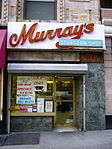St. Ignatius of Antioch Church (New York City)
20th-century Episcopal church buildingsAnglo-Catholic church buildings in the United StatesChurches completed in 1903Churches in ManhattanEpiscopal church buildings in New York City ... and 6 more
Gothic Revival church buildings in New York CityNew York City Designated Landmarks in ManhattanProperties of religious function on the National Register of Historic Places in ManhattanReligious organizations established in 1871Upper West SideWest End Avenue

St. Ignatius of Antioch Episcopal Church is a historic Episcopal church, located at 552 West End Avenue, on the southeast corner of 87th Street, in Manhattan's Upper West Side neighborhood. It was built in 1903 and added to the National Register of Historic Places in 1999. In 2020, it reported 252 members, average attendance of 80, and $274,356 in plate and pledge income.
Excerpt from the Wikipedia article St. Ignatius of Antioch Church (New York City) (License: CC BY-SA 3.0, Authors, Images).St. Ignatius of Antioch Church (New York City)
West End Avenue, New York Manhattan
Geographical coordinates (GPS) Address Website External links Nearby Places Show on map
Geographical coordinates (GPS)
| Latitude | Longitude |
|---|---|
| N 40.789166666667 ° | E -73.977222222222 ° |
Address
Saint Ignatius of Antioch Church
West End Avenue 552
10024 New York, Manhattan
New York, United States
Open on Google Maps










